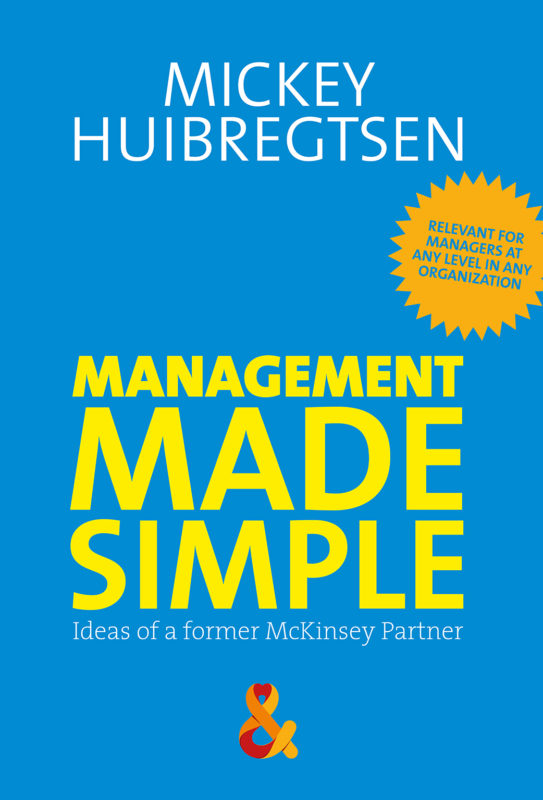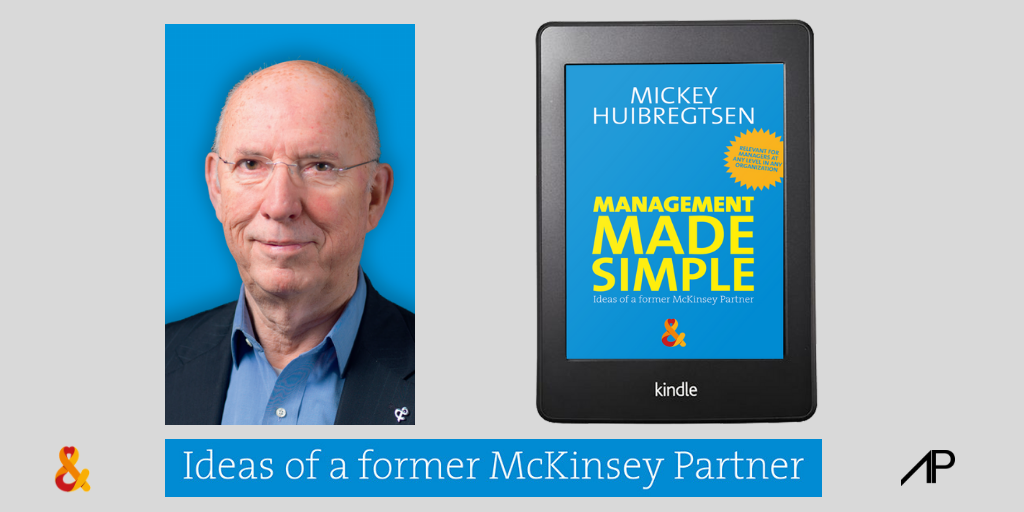
Relevant for managers at any level in any organization
Ideas of former McKinsey partner, Mickey Huibregtsen, who shares his vision and ideas with next generations of leaders. A book about leadership and management.
Management Made Simple is relevant for managers at any level in any type of organization
Our societies have come to the end of the road. We need a fundamental reconstruction of the systems and institutions that now govern us and redefine the roles of all the players with a stronger focus on making things work by respecting the human dimension. This is not a choice between socialism, and capitalism or any other -ism. There is no future for any pure -ism. Life is too complex and interdependent for that. We need organic institutions with a clear view of purpose and values. We need governments that guide and inspire, rather than direct and control. We need corporations that pursue value creation for all stakeholders and finally we need citizens that reassume their personal responsibility for the wellbeing of society.
The world’s complexity grows exponentially in the 2010s and 2020s. And with it the challenge to management at any level of any organization anywhere. The purpose of this book is to help managers deal with this complexity by offering some simple concepts, models and ideas on topics varying from corporate strategy to organization, leadership and operating performance. The working hypothesis in doing so is that there is only one way of dealing with complexity and that is by making things simple.
Should you have written a Management book yourself, please have a look at our Author Services page.
Although not in English, Mickey Huibregtsen launched a publication on the urge to collaborate: Meer Wij. Over Samen Werken in de 21ste eeuw.
The book has been published on Friday 28 June at a conference held at the Rabobank in Utrecht.
Het boek begint met een inleiding waarin de belangrijkste trends de revue passeren die leiden tot een paradigma shift in de manier waarop organisaties functioneren. We gaan van het streven naar perfectie naar het streven naar prestatie, van het leveren van een product of dienst naar het zorgen voor een klant, van het sturen en controleren van medewerkers naar het inspireren en ondersteunen van medewerkers en van het managen van een organisatie naar het bijdragen aan de maatschappij.
Daarna schetst de auteur in Part 1 de ‘business environment’ waarin organisaties moeten werken. Bedrijven krijgen o.a. te maken met ‘the one-person economy’, ‘the service economy en ‘the power of intangibles’. Daarna volgen Part 2 t/m 5. Met in totaal 33 inzichten, modellen of ideeën verdeeld over de thema’s strategie, organisatie, leiderschap en managementtools. Ieder onderwerp wordt in vier pagina’s kort toegelicht met tekst, afbeeldingen, illustraties en praktijkvoorbeelden.
Volgens de auteur is het boek geschikt voor leiders en managers op ieder niveau in de organisatie en helpt het hen om door de bomen het bos te zien. De auteur benadrukt meermaals in het boek dat de onderwerpen die hij aandraagt slechts het topje van de ijsberg is van wat er in de wereld gaande is, maar dat ze de lezer kunnen helpen bij het nadenken over de toekomst.
Management Made Simple is een compact boek van 170 pagina’s. Met een verzameling inzichten, modellen en ideeën die je in meer of mindere mate prikkelen. Met intrigerende namen als The Double Business System, The Organizational Flipover, The Spider Plan en The Piramid Principle. Het boek leest niet altijd even vlot weg. Door de eenvoud en beknoptheid mis je logischerwijze soms wat diepgang waardoor de beschreven oplossingen, tips en praktijkcases soms wel erg ‘simpel’ en minder bruikbaar overkomen. Maar het gaat natuurlijk vooral om die andere mindset die nodig is om succesvol te kunnen zijn in die snel veranderende wereld.
Het is een mooi streven van de auteur om management niet ingewikkelder te maken dan nodig. Dit boek kan je misschien daarbij helpen. Indachtig een van de beroemde spreuken van Albert Einstein die ooit zei: if you can't explain it simply you don't understand it well enough.
Rather than discussing one single topic, Huibregtsen discusses many. The book consists of 5 parts: 1) Business Environment, 2) Strategy, 3) Organization, 4) Leadership and 5) Management Tools. The chapters might be short but they are packed with interesting information and business cases. It takes a clever and analytical mind to present ideas with such clarity. The book definitely gave me food for thought!
Most importantly the book was incredibly helpful in pointing out blind spots in the company (trends, issues or opportunities we completely missed). For example: the importance of human resources. The cultivation of talent and the need to create an environment and culture within the company to inspire its employees which will benefit not only the employee but the company and clients as well. There are many more examples of blind spots the Management Made Simple pointed out to me that could lead to a variety of opportunities that the company hasn’t explored yet, but the emphasis on the emotional revolution and what people today expect, not just from the things or services they purchase but from their own work environment, resonates with me and I believe will with most people.
Reading Management Made Simple, I found myself nodding in agreement to the statements made and solutions offered – they made complete sense. But don’t let that fool you into think that if everything is so obvious, why read it at all? Huibregtsen does a lot of effort to explain complex trends (why they exist or don’t exist anymore) and market strategies (their core principles and why they would or wouldn’t work in the current market). Even when I didn’t understand or was unsure about some of the terms or concepts mentioned, the case studies of strategies implemented in real life were incredibly helpful and inspiring.
I believe that Management Made Simple is a must read for anyone currently in management (on any level) from senior management with years of experience (who still fall pray to these same challenges) to those who aspire to managerial positions in the future – you should never stop preparing or learning where your blind spots are.
The author was a senior partner of McKinsey & Company worldwide, for 28 years. He advised most of the top 50 companies in the Netherlands, as well as many clients elsewhere in Europe and the USA.
"The underlying assumption for the book is that the only way of dealing with complexity is to make things simple, but in the right way," Huibregtsen explains. The cause of this unnerving and escalating complexity are the profound and rapidly unfolding trends.
The trends Huibregtsen cites are: the increasing globalisation of business and politics; the escalation of the role of emotions in all our actions, and the expanding role of corporations in society.
Globalisation isn't going anywhere.
Globalisation is, and will continue to, reshape the economic landscape of our world for years to come, and in my opinion, for the better, for all. Few economic activities are and can possibly be truly isolated from globalisation. In 2000 only between 10 and 15% of the world’s GNP was exposed to international competition. By 2020 this will increase to more than 40%.
The escalating role of emotions in business is easiest to see in the fashion arena where consumers no longer look for a product as they look for a ‘buying experience’. (See Almost is Not Good Enough, By Andrew Jennings reviewed in this column.)
While all trends feed on each other, I will focus primarily on the escalation of the role of emotions.
In the past, most of the factors that were critical to business executives, changed relatively slowly. This allowed us to formulate five-year strategies. Today such a strategy would be absurd. With the rapidity of change and the continuous interaction of critical factors, the very act of identifying cause and effect is dizzying. The increasing uncertainty of outcomes is visible in virtually all aspects of business and organisations.
Products are under the pressure of increasingly effective competition and as a result are approaching ‘commodity status’.
The emotional revolution.
Consider this example: there are no really bad cars anymore, just as there is no bad petrol. The difference in total production costs and price have narrowed. The result is that the emotional aspects of a purchasing decision play a far more important role than an objective fact-based comparison.
The role of emotions affects all aspects of business - employees need to be inspired, advisors to be trusted, suppliers to be relied upon, customers to be touched, and bosses need to be admired.
We have been through the ‘Industrial Revolution’. We have been through the ‘Information Revolution’. We are now experiencing the ‘Emotional Revolution.’
As was the case with the other revolutions, the Emotional Revolution is defining not only management, but virtually every aspect of business. It informs everything from our research and development efforts, to after-sales service, and everything in between.
In the past, we held the belief that an organisation of quality is one that executes perfectly and is totally under control. This expectation is both "impossible and counterproductive", Huibregtsen explains. Since the key elements in business involve managing the emotions, attitudes, and feelings of customers and employees, their expectations have to play an increasingly central role in executive practice.
The emphasis is now on performance more than perfection; on caring for a customer more than merely producing a product. The intangibles require as much curating as the tangibles.
The tangibles in a business – such as the fixed assets – will tend to become more of a burden than a source of competitive advantage. The intangibles, by contrast, will increasingly determine the value and potential of the organisation. This includes intangibles such as reputation and relationships – both internally and externally, to staff and customers.
Both products and services tend to become commodities as a result of increasingly perfect competition between the players in the industry. The value differentials are becoming ever more emotionally driven. Gone are the competitive advantages of the past that were sustainable, and the only cost advantage that is possibly sustainable comes from scale.
Today the competitive advantage is closeness to the customer, reputation and brand, and breakthrough ideas – until these are cloned by a competitor.
Value is in the eye of the beholder.
With the value offering being in the eye of the beholder, it comes in widely different forms. Examples are the quality of personal interaction of South West Airlines; the brand reputation of Unilever; the product functionality and service of Apple; the form of acquisition of IKEA; the exclusivity of Rolex, and more.
As such, the traditional value chain or business model is inadequate. This is because it has always pointed in one direction: towards the customer who is ‘king’. However, since it is intangible requirements that satisfy the ‘king’, businesses require talented staff to deliver this expectation.
The success of the business depends on attracting, developing and retaining the customer or client, by talented staff. In turn, talented staff have to be successfully attracted, developed and retained by the business. "Competition for talent does not end with the acceptance of the offer, but begins there and will last throughout their career," Huibregtsen asserts.
A quantum leap.
In physics, a quantum leap is effectively a discontinuous but relatively small jump from one state of energy to another. However, in business terminology the phrase means a monumental change in the business system, resulting in an equally impressive impact on overall performance.
The business system itself needs constant and ambitious change and Huibregtsen provides some essential tools for the process. These tools include the explanation of how to use the tool, and examples that will be readily recognised.
One of the tools is the elimination of elements of the business system so that it is significantly more effective. For example, the elimination of the need for storage by the adaptation to just-in-time production. Another is ‘product redesign’ as used in the replacement of the cork with the screw cap in the wine industry. And the adoption of new technologies such as those used in the car industry as it shifts away from carbon fuels.
With the growing complexity and rate of change in business, the challenge for executives in any organisation is enormous. But so too is the opportunity to make an impact.
There are few books aimed at senior executives that are as comprehensive, useful and readable as this one. Management Made Simple should not be overlooked.
Readability Light ----+---- Serious Insights High +--------- Low Practical High +--------- Low
*Ian Mann of Gateways consults internationally on strategy and implementation and is the author of ‘Strategy that Works’ and ‘The Executive Update.’ Views expressed are his own.






